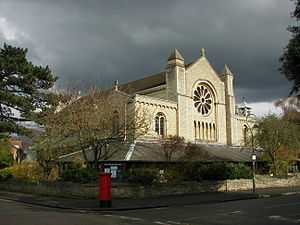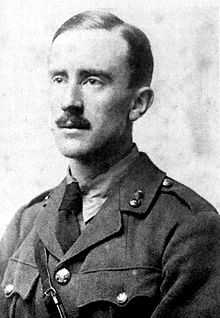Northmoor Road



Northmoor Road is a road in North Oxford, England.[2]
Location
Northmoor Road runs north-south parallel to and east of the Banbury Road. At the northern end is a junction with Belbroughton Road and to the south is a junction with Bardwell Road, location of the Dragon School. Linton Road crosses the road east-west about halfway along.
St Andrew's Church,[1] established in 1907, is on the southeast corner of the junction with Linton Road. Just to the north is Northmoor Place, a row of newer terrace houses. Most of the houses in Northmoor Road are substantial detached residences, built between 1899 and 1930.[2] Many of the earliest houses at the southern end were designed by Harry Wilkinson Moore (1850–1915).[3]
Residents
The most famous resident of Northmoor Road was the Oxford academic and author J. R. R. Tolkien.[4] He lived at No. 22 in 1926–30 and then a larger house at No. 20 in 1930–47. Tolkien wrote The Hobbit and most of The Lord of the Rings while living at 20 Northmoor Road.[5][6] There is now a blue plaque on the house. He later lived at Sandfield Road in Headington.
Another resident was Sir Martin Wood, who in 1959 set up his company, Oxford Instruments, in his garden shed at his house in Northmoor Road. Oxford Instruments went on to become a leading company in medical technology. Later, in the 1980s, Wood founded the Northmoor Trust, aimed at promoting nature conservation at Little Wittenham and Wittenham Clumps in the Oxfordshire countryside south of Oxford.
Charles Firth, Professor of History at the University of Oxford, lived at No. 2 Northmoor Road, a distinctive house with a two-storey bow-front, designed by E. W. Allfrey in 1903–8.[2][7] The house is in the Queen Anne style.[3] The Oxford University historian of science, Professor Margaret Gowing, CBE (1921–1998), lived in Northmoor Place towards the end of her life.[8] Michael Maclagan, Fellow and Tutor in Modern History at Trinity College, herald, and Lord Mayor of Oxford 1970-71, lived for many years at No. 20, Tolkien's former home. The diplomat Sir Julian Bullard (1928–2006) lived in Northmoor Road during his retirement.[9]
See also
References
- ↑ 1.0 1.1 St Andrew's Church, Oxford, UK.
- ↑ 2.0 2.1 2.2 Hinchcliffe, Tanis (1992). North Oxford. New Haven & London: Yale University Press. pp. 125–127, 131, 141, 187, 234. ISBN 0-14-071045-0.
- ↑ 3.0 3.1 Sherwood, Jennifer; Pevsner, Nikolaus (1974). The Buildings of England: Oxfordshire. Penguin Books. p. 324. ISBN 0-14-071045-0.
- ↑ "Northmoor Road". In Humphrey Carpenter, J.R.R. Tolkien: A biography. George Allen & Unwin, 1977, pages 153–160. ISBN 0-04-928037-6.
- ↑ Prudames, David (23 November 2004). "Oxford house where Tolkien wrote Lord of the Rings is listed". Culture24. Retrieved 26 November 2009.
- ↑ Christina Scull & Wayne G. Hammond, The J.R.R. Tolkien Companion & Guide (Houghton Mifflin, 2006), v. 2, p. 694.
- ↑ Saint, Andrew (1970). "Three Oxford architects". Oxoniensia 35.
- ↑ MacLeod, Roy (12 September 2012). "Margaret Mary Gowing CBE FBA. 26 April 1921 – 7 November 1998". Biographical Memoirs of Fellows of the Royal Society (London: The Royal Society). doi:10.1098/rsbm.2012.0027.
- ↑ "Diplomat who played major role in Cold War (Local Obituaries)". The Oxford Times. 2 June 2006.
External links
- Outside 20 Northmoor Road (360° view)
- Outside 22 Northmoor Road (360° view)